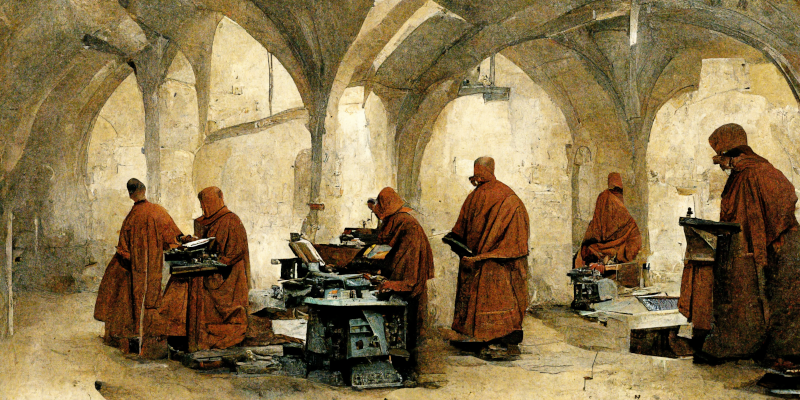August 14, 2022
Workflows
The invention and spread of writing did not turn everyone into a literary creator. Neither did the printing press, typewriters, home printers or word processors. The democratisation of home studios, electronic music equipment and pro-quality plugins did not turn every bedroom muso or DJ into Jean Michel Jarre or Deadmau5. Like Jordan Tanner @jrdntnnr explained to John Flowers, “having the latest, flashiest Nikon camera […] doesn’t automatically make you a professional photographer”.
But digital photography, typewriters, MIDI, DAWs etc have revolutionised practices and disrupted industries nonetheless, like the printing press before them, which made copist monks obsolete in only a few decades.

Dall-E, Midjourney, and other creative tools released recently (or about to be), are threatening to disrupt many creative industries, from graphic designers to screenwriters. New economic models are being experimented with almost daily. Lawyers and other rights professional are also impacted, or will be shortly, to cope with these changes.
This is not an issue specific to the creative industries of course. Like our globally warming oceans, the sea of AI applications is rising everywhere and shrinking hte Moravec Landscape.
The medical technology world has been juggling with these questions for a few years already. And many agree now that even if AI will no replace radiologists, radiologists who don’t use AI will be replaced by those who do.
Will it be the same for Artists and creative industry professionals? Or is it already the case? The challenges are very different between both applications.
In one case - it is puzzling/disturbing to think that tech can now compete with the human mind within a process that is the most intuitive, visceral and emotions-fed of our actions: creativity.
In the other case - the tension and discomfort comes from tech competing with the analytical diagnostic and therapeutic decision making processes that human minds (an the institutions that supervise and regulate them) are expected to conduct in the most rationale, objective, explainable and accountable fashion.
So whilst the reason behind the challenges are very different, their depth and difficulty are comparably significant.
I often use the SWOT model to organise ideas around a topic or challenge.
Beside of threats, it encourages focusing also on opportunities. We rarely evoke the loss of the copist monks when mentioning the printing press. This major innovation offered new opportunities for the content-industry of the time, resulting in a larger and more varied publishing and authoring ecosystem that accelerated the Rennaissance and triggered the Scientific Revolution. Similarly AI offers incredible opportunitites for both creativity and healthcare.
In both the medical and the creative worlds, succesful implementations happen where new tools are invested in, learned and integrated as part of a global workflow. We will discuss this workflow concept, along other points, during the industry panel which I have the honours of chairing on August 19. Registration is free, online or F2F @UNSW Design&Architecture in Paddington. Hope to see you there.
Image generated by Midjourney with /imagine https://media.discordapp.net/attachments/990816843709173800/1008358009837199370/scriptorium.jpg robot monks in a medieval scriptorium –ar 2:1.
Large res here

